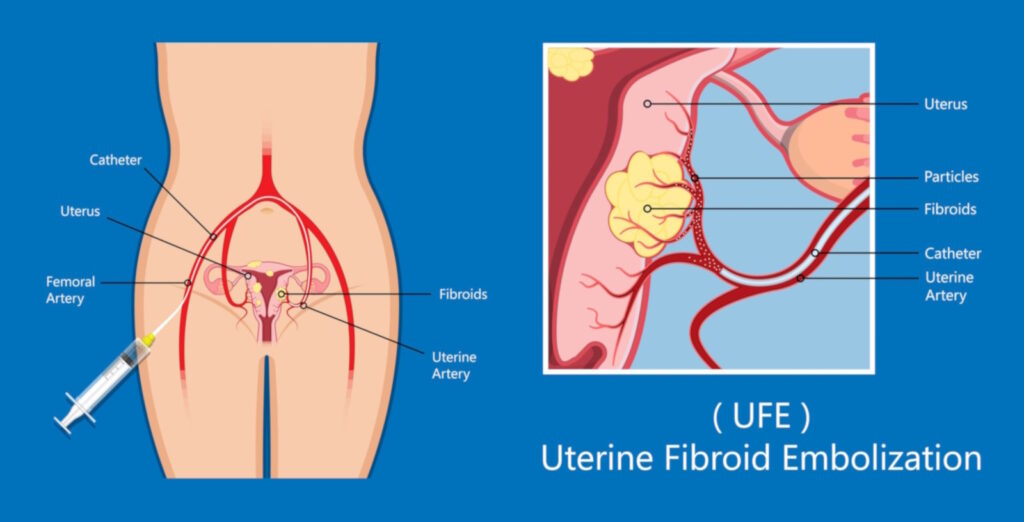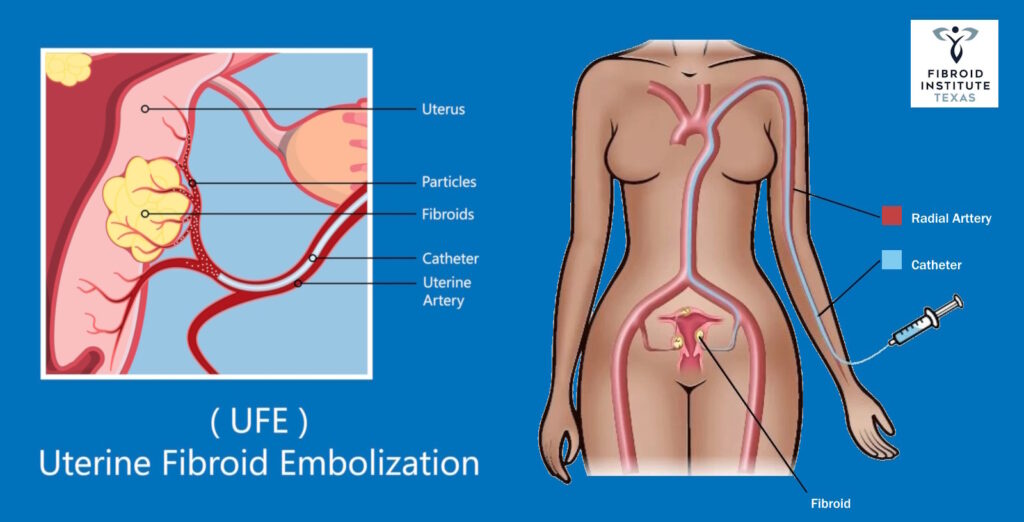Joelle* has suffered from her fibroid symptoms long enough and has decided to take action. That said, she would prefer to pursue the least invasive option possible. Sure, surgical procedures like hysterectomy and myomectomy are effective and were traditionally the go-to recommendation for many doctors—including her own. But this is her body they are talking about. She knows there are other options to resolve her pain and symptoms without affecting the uterus, including a nonsurgical alternative called Uterine Fibroid Embolization (UFE). All that is left is to decide how her UFE procedure should be performed. Throughout her research, Joelle learned that while UFE does not require incisions, there are two ways doctors can access her fibroids: through the femoral artery in the groin or the radial artery in the wrist.
Both approaches share some of the same aspects (no hospital stay, no incisions, fast and efficient) and have similar success rates in treating multiple fibroids at once—thus significantly reducing symptoms. Unlike surgery, UFE does not technically remove fibroids. Rather, a catheter is used to inject tiny particles that block blood flow in nonessential vessels leading to the fibroids. Without this blood flow feeding them, fibroids simply shrink and die. However, like Joelle many women want to first weigh the pros and cons of each approach.
Femoral vs. Radial UFE: A Comprehensive Breakdown
Researchers estimate that 70-80 percent of all women will develop fibroids in their lifetime. These benign tumors formed in the uterus muscle tissue can develop in different locations, differ in size, and either stay that way or grow at different rates. Granted, not all women are aware they have fibroids or experience pain. Still, those who do could experience fibroid symptoms ranging from heavy bleeding to pelvic pain and pressure, weight gain, and irregular periods.

It used to be that when a woman was suffering from painful uterine fibroids, the only option was surgery. All or part of the uterus and possibly the fallopian tubes were removed along with the fibroids, ensuring there was no hope for fibroids to return. Then a non-invasive alternative called Uterine Fibroid Embolization (UFE) came along in the early 1990s and quickly became the gold standard for non-surgical fibroid treatment.
The procedure is a breath of fresh air, particularly for women who want to avoid surgery and lengthy recoveries or are not surgical candidates because they represent a technically challenging case. UFE is also an option for women who have dreams of becoming pregnant in the future.
Most fibroids can be treated with Uterine Fibroid Embolization. This includes those that grow inside the uterine walls (intramural fibroids), just underneath the uterine lining (submucosal fibroids), outside the uterus (subserosal fibroids), or on a long stalk inside or outside of the uterus (pedunculated fibroids). Studies have shown that nearly 90 percent of women who undergo UFE experience significant or complete resolution of their fibroid-related symptoms.
UFE has always been a low-risk alternative to surgery. As time has passed, interventional radiologists have become even more savvy about how to best perform the procedure.
Femoral Approach
Traditionally, Uterine Fibroid Embolization has been performed through the femoral artery in the groin. You have one in both legs—one in each upper thigh in an area called the femoral triangle. This large blood vessel branches off into different sections as it travels down the leg, and its primary purpose is to provide oxygenated blood to your lower extremities.
The biggest benefit of the femoral approach to UFE is that accessing the femoral artery is easy—even without ultrasound. It is also the shortest path to a woman’s pelvic region, allowing doctors to insert the catheter and guide it quickly to the blood vessels that feed the fibroids of the uterus. The interventional radiologist chooses the size of the embolic material to ensure that only the blood supply to the fibroids is blocked and not that of the surrounding organs. Due to their texture and shape, the materials are confined to the specific blood vessels related to your individual fibroids and create a blockage that keeps the fibroids from receiving the nutrients they need to survive.

The femoral approach is still a popular option today, depending on the uniqueness of each fibroid case. That said, an increasing number of fibroid specialists have steered away from it because of several downsides.
- Risk of bleeding — The artery’s diameter varies widely by sex, weight, height, and ethnicity. But it is usually between 7 and 8 millimeters across (about a quarter-inch). As a result, the risk of bleeding is higher and requires lengthy compression if the closure device does not adequately seal the wound.
- Immobility — Patients who undergo a femoral UFE procedure must lie flat for two hours after the procedure. This allows the closure device and compression processes to close the hole in the blood vessel. If they get up and move around too quickly, a series of complications could arise.
- Vascular injuries — Blood vessels are strong, interconnected highways that keep blood flowing throughout our body. That said, they are not immune to injury or tears. This can cause excess bleeding from the treatment site.
- It is not for everyone — Some women are not candidates for the femoral approach. This is particularly true for women who are overweight, as doctors may struggle to access the artery.
Radial Approach
As Uterine Fibroid Embolization has been fine-tuned over the years, the radial artery in the wrist is another viable option. Granted, using the radial approach requires doctors to guide the catheter through a much longer path, given that this artery runs on the inside of the forearm from the elbow to the thumb. As a result, the catheter must travel up the arm and through the body to the uterine artery. That said, modern medicine and X-ray-guided imagery have advanced tremendously over the years. Catheters have also become smaller, allowing for quick and painless access.

From there, the procedure is relatively the same.
- Your interventional radiologist makes an even smaller incision on the wrist.
- Tiny particles are injected into the body by a catheter.
- The embolic material quickly goes to work, blocking nonessential blood vessels leading to the fibroids.
The result is relief from a variety of uncomfortable symptoms, including but not limited to the following:
- Painful periods, including heavy or inconsistent cycles
- Debilitating cramps, pelvic pain, and pressure
- Back or leg pain
- Bloating or swelling in the lower abdomen
- Weight gain, an extended-looking abdomen
- Pain during sexual intercourse
- Urinary frequency
- Constipation, diarrhea, and rectum discomfort
That said, there are a few negatives to consider:
- Not everyone is a candidate — Your radial artery must be large enough to accommodate the catheter. If not, doctors will use the femoral approach to achieve a successful outcome.
- Technical difficulty — UFE through the radial artery cannot be performed by just anyone. This artery is significantly smaller than the femoral artery and more challenging to access. Therefore, the interventional radiologist you choose must be trained and experienced in this approach.
Fibroid Institute Prefers the Radial Artery Approach to UFE Procedures
We believe one reason Fibroid Institute’s approach to Uterine Fibroid Embolization stands out against other providers is because we use the radial (wrist) method. Fibroid patients have already been through so much with their painful symptoms—so why add more potential complications to the mix? Our highly experienced fibroid doctors accessing through the wrist (nothing more than a small needle prick) has consistently decreased patient pain during and after the procedure versus advancing the catheter through the groin area.
Once the procedure is complete (usually in roughly an hour), you will notice only a small bandage over the nick on your wrist. From there, we follow a highly specific pain management algorithm. As a result, patients report little to no pain at all when they follow the recommended medicine protocol.

The biggest benefit of this approach is a faster recovery. Rather than lying down for two hours post-procedure, patients can sit up almost immediately and be discharged the same day in most cases. There is also a lower risk of bleeding and no need for vascular closure devices.
Our team of fibroid experts at Fibroid Institute want all women to know that they do not have to suffer in silence with fibroid symptoms or be caught off guard by the diagnosis, regardless of their age or degree of condition. Whether you are just now experiencing symptoms or have struggled for years, we are here to guide you every step of the way, offering expert care and compassionate solutions tailored to your needs.
In saying this, it is important to note that not all women are candidates for UFE. In some instances, surgery may be the best path forward to ensure you can live your life pain-free. That said, it is important to do your research and have open and honest discussions with your healthcare team. Doing so ensures you know all the facts and potential treatment options. Whether UFE is the right option for you or not, our team of fibroid doctors is always on hand to partner with you and your doctor to determine the best course of action.
Fibroid Institute Is 100% Focused on Eliminating Fibroid Symptoms
At Fibroid Institute Texas, we do not believe you need to decide between suffering in silence and having invasive surgery. We treat fibroids using Uterine Fibroid Embolization (UFE), the gold standard in non-surgical fibroid treatment. With multiple locations, our Dallas and Houston fibroid clinics help thousands of women avoid fibroid surgery and find relief from their fibroid symptoms.
Very few practices across the country are dedicated 100% to fibroid treatment. That is where Fibroid Institute makes its mark. The concierge model at Fibroid Institute means patients get personalized and complete care from the initial consultation through post-procedure follow-ups. UFE patients can access their fibroid doctor’s mobile number to call or text with questions and concerns.

In addition to prioritizing patient needs, Fibroid Institute is helping to reduce the healthcare costs of fibroid treatment. UFE is an outpatient procedure that does not require a hospital stay, thus costing less than traditional fibroid surgeries such as hysterectomy.
Furthermore, we have perfected our approach to this life-changing procedure and believe the radial artery achieves the best results in the least invasive way. In utilizing the radial artery, we are simply making a tiny nick on the patient’s wrist, guiding the catheter to the fibroid location, and cutting off blood supply. In doing so, you should experience significant improvement in your fibroid symptoms. You can also get up, move around, and leave our office on the same day. Most patients find that they are back to their normal way of life within a matter of one week.
Get started now in Dallas by calling 214-838-6440, in Houston by calling 713-903-3733, or complete the form below. We are dedicated to helping you become #FibroidFree.
Fibroid Institute Texas serves the Dallas and Houston areas including Houston, Sugar Land, Katy, Webster, Clear Lake, The Woodlands, Universal City, Spring, Kingwood, Stafford, Conroe, Texas City, Cypress, League City, Bellaire, Addison, Carrollton, Plano, Frisco, Craig Ranch, McKinney, Allen, Fort Worth, Grand Prairie, Hurst, Euless, Bedford, Arlington, Hutchins, Irving, Duncanville, DeSoto, Cedar Hill, Lancaster, Cockrell Hill, Highland Park, University Park, Park Cities, Garland, Mesquite, Richardson, Dallas, Sherman, and more.
This information is not a substitute for professional medical advice. Prior to starting any new treatment or if you have questions regarding a medical condition, always seek the advice of your doctor or other qualified health provider.
*Patient names and/or photos may be changed to protect patient confidentiality.

